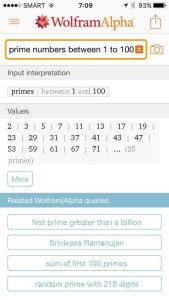Exploring Wolfram Alpha for iOS
I am a fan of free apps and I have promoted a lot of them in this blog, but there are times that I also purchase premium apps. For the past few days, I have been exploring Wolfram Alpha for iOS which can be purchased in iTunes for $2.99. For those who have not heard about it yet, it is a knowledge engine developed by Wolfram Research. In layman’s words, it is an engine that answers factual queries and returns curated data rather than a list of files or web pages which is what search engines do. For example, if you search “primes between 1 and 100,” it returns the list of primes as shown below. To know more about Wolfram Alpha, you can read my introductory post about it here.
Wolfram Alpha covers a wide variety of topics. This includes mathematics, linguistics, dates and times, chemistry, money and finance, physics, health and medicine, engineering, geography, transportation, weather and meteorology, and many more.
Another unique feature of the iOS app is it is directly connected to Siri. You can just ask Siri about your queries and Siri will return answers from Wolfram Alpha. For devices without Siri, you can also type your queries. In iOS devices, a special keyboard with mathematical symbols appear every time you access Wolfram Alpha.
You can also download the FREE Wolfram Alpha Viewer to explore Wolfram Alpha results from Siri and learn how to use the commands effectively. You can also access Wolfram Alpha online.
